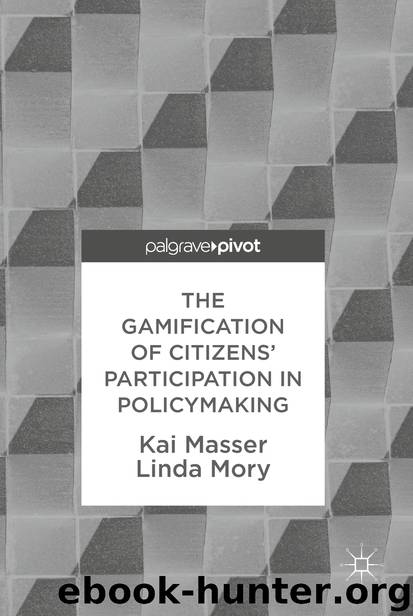The Gamification of Citizens' Participation in Policymaking by Kai Masser & Linda Mory

Author:Kai Masser & Linda Mory
Language: eng
Format: epub
Publisher: Springer International Publishing, Cham
It seems that it is the political parties and the people behind the parties that citizens do not trust. All relevant surveys uniformly confirm this “tricky-dicky-effect” (“tricky-dicky” is the derisive nickname of former US President Milhouse Richard) as causing a decline in the trust of politics and politicians in Western countries. The result is a growing disenchantment with politics. At this point it is worth looking back at Schumpeter who argued—maybe somewhat precipitately—that “beyond direct democracy lies an infinite wealth of possible forms in which the ‘people’ may partake in the business of ruling or influence or control those who actually do the ruling” (Schumpeter 1942).
According to the empirical findings presented in the previous sections, most people do not want to take part in the political decision making personally but want to be informed, control the political establishment and have the right by referendum to stop political elites. To complete the Schumpeter quotation: “None of these forms [by which people partake or control], particularly none of the workable ones, has any obvious or exclusive title to being described as Government by the People […]: the people never actually rule but they can always be made to do so by definition” (Schumpeter 1942). This means that unfortunately, the famous Abraham Lincoln Gettysburg Address of November 19, 1863 should be modified: Democracy is not a government of, by, and for the people, it is rather a government of, for, and hence necessarily controlled by the people.
Schumpeter (1942) pointed out that a total direct democracy where all decisions are made by all of the people is only possible in very small communities like the ancient Greek polis or the New England towns. Despite the disenchantment of the people with political parties, elections of politicians together with referenda are still the most popular democratic instruments in Germany by far. Advocates of deliberation and dialogue-based measures (Nanz and Kamlage 2013) together with the media insist on declaring a diminishing voter turnout in Germany. This is simply not true. Looking at the development of the turnout rates in Germany since 1945, it becomes clear that there is a remarkable decreasing voter turnout especially at the municipal level (Masser and Fischer 2015). At the state and in particular at the federal level, voter turnouts have cyclical fluctuations but remain relatively stable. The turnout levels since 1990 match the delineated order of importance of the different hierarchical political levels perfectly. Elections at the federal state level have the highest voter turnouts followed by the state level. Voter turnouts at the local and municipal levels have experienced a dramatic decline. The problem of the false assumption of a diminishing voter turnout can perhaps be traced to German Unification in 1989. The voter turnout in the six new federal states remained significantly lower than in the old West German states (Bundeszentrale für politische Bildung 2013). Worth mentioning is, that since 2009 there has been a trend of increasing voter turnout in the new East German States. In Saxony, the voter turnout in federal elections in 2009 was 65.
Download
This site does not store any files on its server. We only index and link to content provided by other sites. Please contact the content providers to delete copyright contents if any and email us, we'll remove relevant links or contents immediately.
| Anthropology | Archaeology |
| Philosophy | Politics & Government |
| Social Sciences | Sociology |
| Women's Studies |
The remains of the day by Kazuo Ishiguro(8893)
Tools of Titans by Timothy Ferriss(8305)
Giovanni's Room by James Baldwin(7254)
The Black Swan by Nassim Nicholas Taleb(7058)
Inner Engineering: A Yogi's Guide to Joy by Sadhguru(6752)
The Way of Zen by Alan W. Watts(6555)
Asking the Right Questions: A Guide to Critical Thinking by M. Neil Browne & Stuart M. Keeley(5709)
The Power of Now: A Guide to Spiritual Enlightenment by Eckhart Tolle(5680)
The Six Wives Of Henry VIII (WOMEN IN HISTORY) by Fraser Antonia(5456)
Astrophysics for People in a Hurry by Neil DeGrasse Tyson(5151)
Housekeeping by Marilynne Robinson(4395)
12 Rules for Life by Jordan B. Peterson(4276)
Double Down (Diary of a Wimpy Kid Book 11) by Jeff Kinney(4242)
The Ethical Slut by Janet W. Hardy(4215)
Skin in the Game by Nassim Nicholas Taleb(4205)
Ikigai by Héctor García & Francesc Miralles(4173)
The Art of Happiness by The Dalai Lama(4092)
Skin in the Game: Hidden Asymmetries in Daily Life by Nassim Nicholas Taleb(3962)
Walking by Henry David Thoreau(3923)
